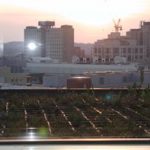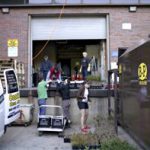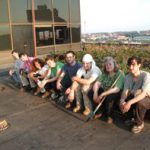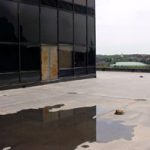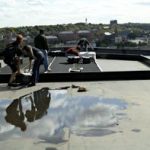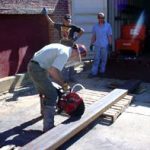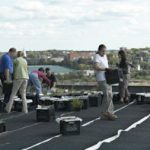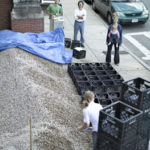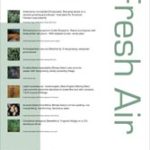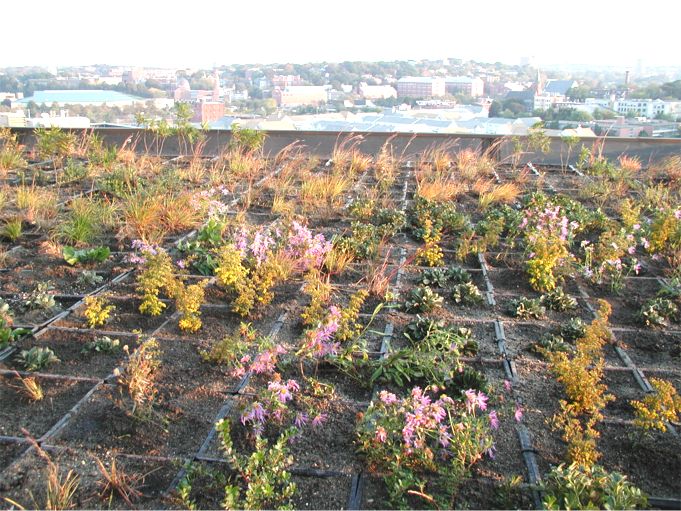
Additional Resources
Massachusetts College of Art and Design (MassArt) is located at 621 Huntington Ave, Boston, MA 02115 (not necessarily the address of the greenroof); (617) 879-7000.
The numerous Designers of Record include: Spring 2006 Design Class Students: Karin Sharav-Zalkind, Jackie Adams, Trevor Andersen, Danielle Blodgett, Ifrane Brennan, Kris Brennen; MassArt Supporter: Patricia Seitz, Professor, Sustainable Architecture class and Coordinator Architecture Program, MassArt; Steel Supplier: Turner Steel; Milk Crate Supplier: I-PAK; Plant Material Growing off-site: New England Wild Flower Society, North Creek Nurseries, Boston Natural Areas Network; President & Future Consultant for Railings and Kinetic Sculpture: Bob Thorne, IDF Industrial Design & Fabrication.Photos of the construction have been taken by Lucas Foglia; Presentation Banners, which have been displayed at the roof garden conference in Boston 2006, have been designed by Karin Sharav-Zalkind with images from classmates.
For more info, please contact Professor Patti Seitz, Architecture / Department of Environmental Design, at: pseitz@massart.edu, or visit www.massart.edu.
News
See the Presentation Banner #1, Breath of Fresh Air and #2, MassArt Green Roof Goals in PDF.
The MassArt (Massachusetts College of Art and Design) green roof pilot project, initiated through a grant for the class of Sustainable Architecture taught in spring, 2006, was a course that in 2005 included a project for a green roof on campus. The students designed and constructed a green roof as part of the coursework. It was proposed as a permanent structure on campus, and is located on an existing flat roof accessible from a large conference area, the Trustees Room, on the 11th floor of what is called the Tower Building.
The project proposed a 1000 square foot planted garden and a small walkway of approximately 250 square feet accessed from both the Trustees Room and the President’s Gallery. The garden portion (750 square feet) was constructed, and the steel is in place for the proposed walkway. Though materials are on site for the walkway (and they were all donated). It was built in 2007, when the weather turned warm again; the planting took place on June 9th, 2007.
Alumni and designer Karin Sharav-Zalkind said, “After receiving the grant, our sustainable class had taken a sharp turn from the theoretical to the actual; being one of the most powerful lessons in my years of study of architecture and design.”
Professor Seitz said,
“Our proposal was accepted by the state to be a pilot. Our goal is to demonstrate water retention – reduction of stormwater into the city system; and a reduction in the temperature ranges at the roof that will translate into savings both in winter (through increased insulation value) and summer (through decreased temperatures at the roof). We also believe that the planted roof, viewed from the Trustees Room and Gallery, and accessible from both of these locations, will add to the quality of this otherwise largely desolate black rubber roofscape over which these areas now view. The goal is also to demonstrate a range of plant species native to the landscape that would be replicated by the conditions of an 11th story roof garden facing southwest. This includes extreme heat, cold, lack of wind protection and high wind speeds.
We received a $10,000 pilot grant from the Executive Office of Environmental Affairs, MA. The roof has a south west exposure, and presents a few challenges: working with live materials we must work with the planting schedules and timing of these materials. The students designed the roof and garden through the spring semester. Toward the end of the semester (May 2006), they selected native plant materials for their design. This material was then grown off-site and was planted in early fall. Due to high winds in the hurricane season, we were obligated to develop a system to “weight” the planting crates, so they stay on the roof. We developed a surrounding steel frame that was lashed to the crates (and the crates to each other). The students, faculty and consultants obtained materials at great discounts, or free. We spent out the grant money, and obtained much of the material at 1/2 to 2/3 the total costs.”
 Greenroofs.comConnecting the Planet + Living Architecture
Greenroofs.comConnecting the Planet + Living Architecture
